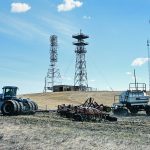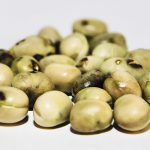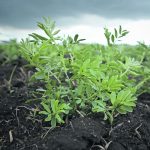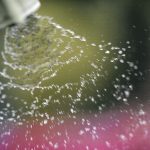UPDATED – March 25, 2024 – 0825 CST – Glacier FarmMedia – Let’s get the obvious part out of the way. By separating “the good stuff” (protein, starch and dietary fibre) from faba beans, a University of Alberta researcher has improved on a process that minimizes human flatulence from eating them. That issue has long […] Read more
Tag Archives Pulse Producer

Management best bet for pulse success
Crop rotation, seeding depth and rate and root characteristics all play a role for pulse crops going into a dry year
There’s a farmer adage that goes, “we’ve never lost a crop in the middle of winter.” In other words, there’s no point speculating on what the growing season is going to be like before the first rainfall. That said, it’s looking more and more likely that 2024 will be another dry year. For many pulse […] Read more
Developing pulses particular to the Prairies
Ana Vargas and her U of S team are working to develop disease resistance, tall red lentils and drought-resistant fababeans
CALGARY – A scientist who seeks to breed lentils and fababeans that are a better fit for the Canadian Prairies in an era of climate change sees a bright future for the region’s pulse farmers. The ability of such crops to fix their own nitrogen means they require less fertilizer and provide high levels of […] Read more
Fababeans attractive option for 2024
BRANDON — A shift toward pulse crops could be the seeding trend of 2024. Agriculture Canada is forecasting more acres of peas, lentils and other pulses this spring because those crops may steal acres from canola. “Peas will be up five percent, lentils eight percent and chickpeas 17 percent compared to last year,” The Western […] Read more

Finding the best pulse for a dry year
Although it’s too early to tell for sure, trusted sources are suggesting drought conditions on the horizon for 2024. According to Agriculture Canada’s Canadian Drought Monitor in its December 2023 drought assessment, 100 percent of the prairie region at month-end was classified as abnormally dry or in moderate to exceptional drought. This includes all of the […] Read more

Online resources support pulse crop planning
Online tools are available to help pulse growers work their way through a number of key management decisions. Here are a few dedicated to the prairie provinces. Saskatchewan There’s an online tool for lentil growers who are wondering if they are at risk of aphanomyces root rot in their fields. Related stories: Lentil carryout to […] Read more

Should I spray or should I go?
Deciding on a fungicide application to control mycosphaerella blight (aka ascochyta blight) in field peas can be difficult. Many variables are at play, including disease occurrence, product selection, application timing, single versus double treatments, application costs and potential returns on investment. To help, a fungicide decision worksheet is available to take some of the guesswork […] Read more

Slow down, up the volume, reduce the pressure
A spraying specialist weighs in on how producers can achieve effective deep canopy coverage while applying fungicides
In Agrimetrix research conducted in chickpeas and field peas, water volume was the most important factor associated with good canopy penetration.
Seeking sources of pea root rot resistance
Pea breeders are heading back to U.S. and French roots in search of genes for durable resistance against aphanomyces
Greenhouse testing at the University of Saskatchewan has shown that several pea varieties have partial resistance. But those results come with a large asterisk: indoor conditions are very different from field conditions.
Risk evaluation app predicts lentil disease
Growers are tempted to shorten their rotation because of high profit potential but the biggest enemy of lentils is aphanomyces root rot. Its spores can remain viable in the soil for a decade or longer.




